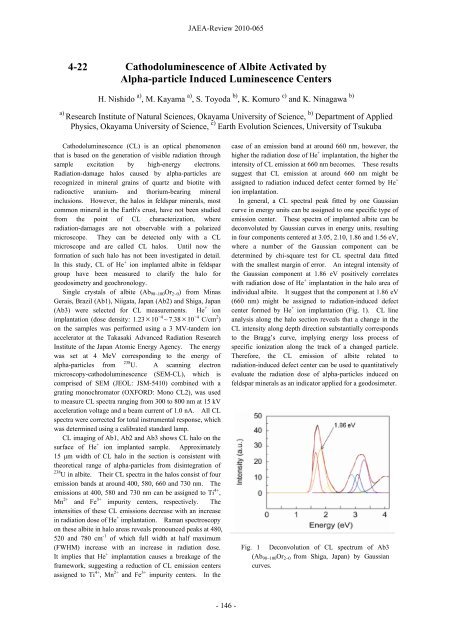JAEA-Review-2010-065.pdf:15.99MB - 日本原子力研究開発機構
JAEA-Review-2010-065.pdf:15.99MB - 日本原子力研究開発機構
JAEA-Review-2010-065.pdf:15.99MB - 日本原子力研究開発機構
You also want an ePaper? Increase the reach of your titles
YUMPU automatically turns print PDFs into web optimized ePapers that Google loves.
4-22<br />
Cathodoluminescence of Albite Activated by<br />
Alpha-particle Induced Luminescence Centers<br />
H. Nishido a) , M. Kayama a) , S. Toyoda b) , K. Komuro c) and K. Ninagawa b)<br />
a) Research Institute of Natural Sciences, Okayama University of Science, b) Department of Applied<br />
Physics, Okayama University of Science, c) Earth Evolution Sciences, University of Tsukuba<br />
Cathodoluminescence (CL) is an optical phenomenon<br />
that is based on the generation of visible radiation through<br />
sample excitation by high-energy electrons.<br />
Radiation-damage halos caused by alpha-particles are<br />
recognized in mineral grains of quartz and biotite with<br />
radioactive uranium- and thorium-bearing mineral<br />
inclusions. However, the halos in feldspar minerals, most<br />
common mineral in the Earth's crust, have not been studied<br />
from the point of CL characterization, where<br />
radiation-damages are not observable with a polarized<br />
microscope. They can be detected only with a CL<br />
microscope and are called CL halos. Until now the<br />
formation of such halo has not been investigated in detail.<br />
In this study, CL of He + ion implanted albite in feldspar<br />
group have been measured to clarify the halo for<br />
geodosimetry and geochronology.<br />
Single crystals of albite (Ab 98~100Or 2~0) from Minas<br />
Gerais, Brazil (Ab1), Niigata, Japan (Ab2) and Shiga, Japan<br />
(Ab3) were selected for CL measurements. He + ion<br />
implantation (dose density: 1.23 × 10−4 ~ 7.38 × 10−4 C/cm 2 )<br />
on the samples was performed using a 3 MV-tandem ion<br />
accelerator at the Takasaki Advanced Radiation Research<br />
Institute of the Japan Atomic Energy Agency. The energy<br />
was set at 4 MeV corresponding to the energy of<br />
238<br />
alpha-particles from U. A scanning electron<br />
microscopy-cathodoluminescence (SEM-CL), which is<br />
comprised of SEM (JEOL: JSM-5410) combined with a<br />
grating monochromator (OXFORD: Mono CL2), was used<br />
to measure CL spectra ranging from 300 to 800 nm at 15 kV<br />
acceleration voltage and a beam current of 1.0 nA. All CL<br />
spectra were corrected for total instrumental response, which<br />
was determined using a calibrated standard lamp.<br />
CL imaging of Ab1, Ab2 and Ab3 shows CL halo on the<br />
surface of He + ion implanted sample. Approximately<br />
15 μm width of CL halo in the section is consistent with<br />
theoretical range of alpha-particles from disintegration of<br />
238<br />
U in albite. Their CL spectra in the halos consist of four<br />
emission bands at around 400, 580, 660 and 730 nm. The<br />
emissions at 400, 580 and 730 nm can be assigned to Ti 4+ ,<br />
Mn 2+ and Fe 3+ impurity centers, respectively. The<br />
intensities of these CL emissions decrease with an increase<br />
in radiation dose of He + implantation. Raman spectroscopy<br />
on these albite in halo areas reveals pronounced peaks at 480,<br />
520 and 780 cm -1 of which full width at half maximum<br />
(FWHM) increase with an increase in radiation dose.<br />
It implies that He + implantation causes a breakage of the<br />
framework, suggesting a reduction of CL emission centers<br />
assigned to Ti 4+ , Mn 2+ and Fe 3+ impurity centers. In the<br />
<strong>JAEA</strong>-<strong>Review</strong> <strong>2010</strong>-065<br />
- 146 -<br />
case of an emission band at around 660 nm, however, the<br />
higher the radiation dose of He + implantation, the higher the<br />
intensity of CL emission at 660 nm becomes. These results<br />
suggest that CL emission at around 660 nm might be<br />
assigned to radiation induced defect center formed by He +<br />
ion implantation.<br />
In general, a CL spectral peak fitted by one Gaussian<br />
curve in energy units can be assigned to one specific type of<br />
emission center. These spectra of implanted albite can be<br />
deconvoluted by Gaussian curves in energy units, resulting<br />
in four components centered at 3.05, 2.10, 1.86 and 1.56 eV,<br />
where a number of the Gaussian component can be<br />
determined by chi-square test for CL spectral data fitted<br />
with the smallest margin of error. An integral intensity of<br />
the Gaussian component at 1.86 eV positively correlates<br />
with radiation dose of He + implantation in the halo area of<br />
individual albite. It suggest that the component at 1.86 eV<br />
(660 nm) might be assigned to radiation-induced defect<br />
center formed by He + ion implantation (Fig. 1). CL line<br />
analysis along the halo section reveals that a change in the<br />
CL intensity along depth direction substantially corresponds<br />
to the Bragg’s curve, implying energy loss process of<br />
specific ionization along the track of a changed particle.<br />
Therefore, the CL emission of albite related to<br />
radiation-induced defect center can be used to quantitatively<br />
evaluate the radiation dose of alpha-particles induced on<br />
feldspar minerals as an indicator applied for a geodosimeter.<br />
Fig. 1 Deconvolution of CL spectrum of Ab3<br />
(Ab 98~100Or 2~0 from Shiga, Japan) by Gaussian<br />
curves.

















